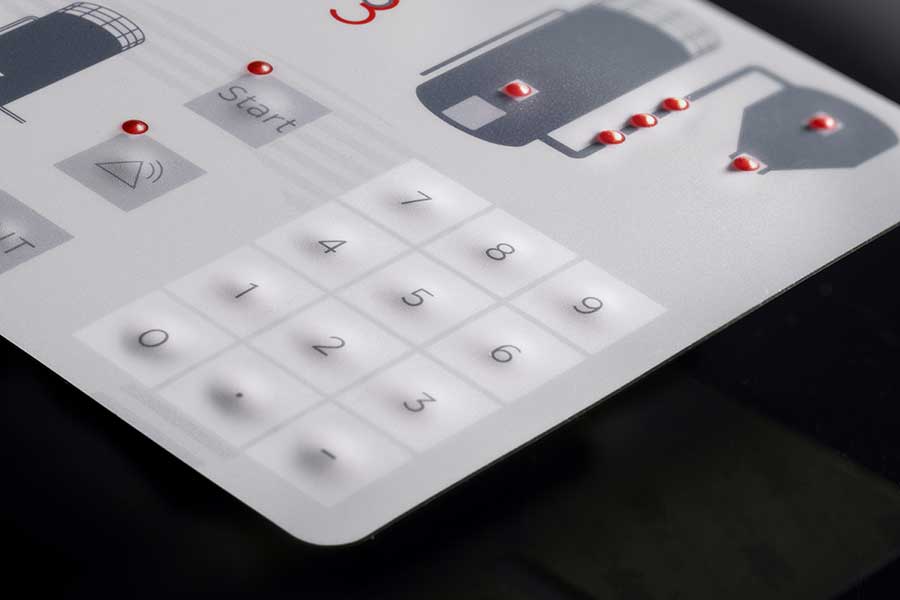Why Membrane Switches Are Vital for Sturdy Control Equipment
Membrane switches play a critical function in making sure the longevity and integrity of control systems across various industries. Their distinct building enables them to withstand tough ecological variables such as moisture, temperature level extremes, and physical wear. This strength not only expands the lifespan of the systems they serve yet additionally decreases upkeep demands. As we discover the complex benefits of membrane layer buttons, it becomes noticeable that their value goes beyond plain performance, affecting customer experience and operational efficiency. What additional ramifications do these features hold for the future of control system design?
Summary of Membrane Layer Buttons
Membrane buttons are versatile and trusted elements commonly made use of in various digital control systems. These switches are composed of several layers, consisting of a visuals overlay, a spacer layer, and a printed circuit layer. The visuals overlay offers both useful and aesthetic layout, while the spacer layer ensures that the buttons are triggered only when pushed. The published circuit layer contains conductive traces that complete an electrical circuit when the membrane layer is pressed, allowing the tool to respond to customer inputs.
Membrane layer switches are typically preferred in applications requiring a compact and light-weight layout, making them perfect for portable devices, medical devices, and commercial equipment. They can be tailored to fulfill specific user demands and can integrate numerous features such as backlighting, responsive feedback, and several shades. Moreover, membrane layer switches are immune to dirt, moisture, and impurities, making them suitable for environments where sturdiness is vital.
Advantages of Longevity
In many applications, the resilience of membrane switches offers significant benefits that boost their overall performance and dependability. These buttons are designed to endure extreme settings, making them ideal for use popular conditions such as high humidity, severe temperature levels, and direct exposure to chemicals. Their durable building and construction aids to protect against damages from physical effect, making sure resilient performance and reducing the demand for constant substitutes.
Furthermore, membrane switches are immune to put on and tear, which is vital in applications where regular interaction occurs. This durability converts to reduce maintenance costs, as companies gain from decreased downtime and fewer solution disruptions. The encapsulated style of membrane switches over safeguards internal parts from dust and dampness access, additional contributing to their life-span (membrane switch).
One more benefit is their capability to maintain constant performance gradually. With a high tolerance for mechanical stress and anxiety, these switches maintain their tactile responses and electric integrity, making certain individual contentment. Eventually, the sturdiness of membrane switches over not only boosts operational effectiveness but likewise cultivates confidence in their integrity, making them a recommended option for control systems throughout various markets.
Applications in Various Industries
Resilient control systems using membrane switches locate extensive applications across an array of industries, each gaining from the distinct qualities these buttons provide. In the clinical field, membrane switches are important for tools such as client screens and analysis tools, where reliability and simplicity of cleaning are vital. Their resistance to moisture and pollutants guarantees they maintain performance in sterile atmospheres.
The vehicle sector leverages membrane layer buttons for dashboard controls and infotainment systems, where they offer smooth, inconspicuous interfaces that boost individual experience. These buttons are additionally designed to endure extreme problems, consisting of direct exposure to severe temperature levels and resonances.
In commercial setups, membrane layer buttons are generally used in machinery control panels, providing tactile feedback and toughness needed for high-usage applications. Their capacity to withstand chemicals makes them appropriate for producing atmospheres where spills and impurities are constant.

Customer electronics, such as kitchen home appliances and push-button controls, likewise utilize membrane buttons for their versatility and cost-effectiveness. Overall, the adaptability and robust nature of membrane layer changes make them important across different industries, guaranteeing efficient operation and long life in control systems.
Layout and Visual Charm
While functionality is paramount, the layout and aesthetic allure of control systems geared up with membrane buttons play a critical duty in individual interaction and total experience (membrane switch). The visual read more style of these switches can significantly affect user assumption and interaction. A well-designed membrane layer switch improves the attractiveness of the gadget, making it more enticing to individuals and promoting a connection between the customer and the product
Membrane layer switches over provide a great offer of flexibility in layout, enabling makers to customize graphics, colors, and appearances to align with brand name identity and product aesthetics. Using vibrant colors and distinct patterns can draw interest, while tactile responses can reinforce the individual's communication with the device. Furthermore, the capacity to integrate LED signs and backlighting right into the membrane switch layout provides both useful and visual advantages, boosting presence and use in various environments.
Enhancing Customer Experience

Furthermore, membrane buttons can be customized to incorporate graphical interfaces, enhancing usability by providing info in a clear and user-friendly way resource (membrane switch). This personalization can include icons, labels, and shade coding that overview customers with complicated functionalities easily. Additionally, their adaptability permits combination in different atmospheres, guaranteeing consistent performance whether in commercial equipment or customer electronics
The sturdiness of membrane switches also plays an essential role in customer experience. By enduring harsh problems and prolonged usage, these buttons minimize the chance of system failures, hence advertising dependability and customer confidence. Inevitably, the critical use of membrane layer switches over not only boosts performance yet likewise substantially enriches user communication with control systems, making them an essential component in modern layout.
Verdict
